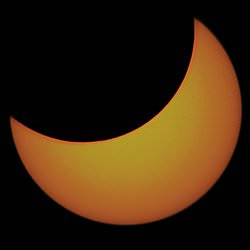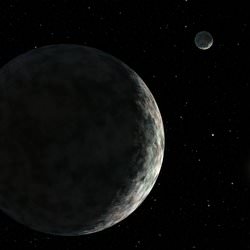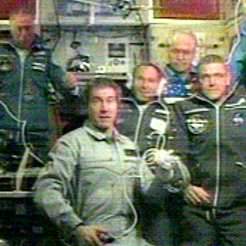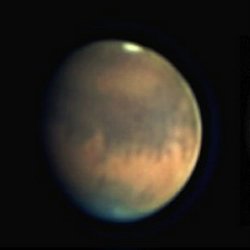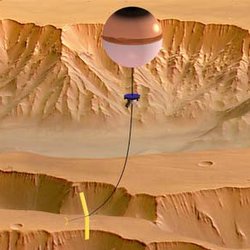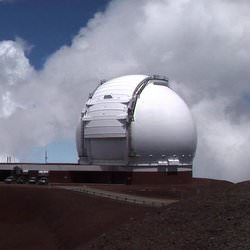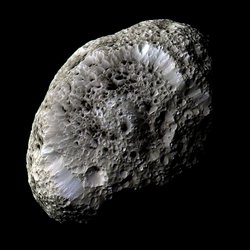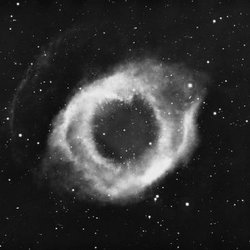
The Helix Nebula. Image credit: NOAO/AURA/NSF. Click to enlarge.
Monday, October 3 – Today marks a terrific event as viewers in Africa had a chance to witness an annular solar eclipse. Many parts of both Europe and Asia were also treated to a partial eclipse as well, so be sure the check the pages of Mr. Eclipse for links to times, locations, images, etc.
For those of us who didn’t get to see the solar ring, let’s look for a ring of another type. Tonight’s dark sky object is a difficult one for northern observers and is truly a challenge. Around a handspan south of Zeta Aquarii and just a bit west of finderscope star Upsilon is a remarkably large area of nebulosity that is very well suited to large binoculars, rich field telescopes and wide field eyepieces. Are you ready to walk into the “Helix”?
Known as NGC 7293, this faint planetary nebula “ring” structure is around half the size of the full Moon. While its total magnitude of 6.5 and large size should denote an easy find, the “Helix” is anything but easy because of its low surface brightness nature. Binoculars will show it as a large, round, hazy spot while small telescopes with good seeing conditions will have a chance to outshine larger ones by using lower power eyepieces to pick up this braided ring structure.
As one of the very closest of planetary nebula, the NGC 7392 is very similar in structure to the famous “Ring” – M57. It is a spherical shell of gas lighted by an extremely hot, tiny central star that’s only around 2% of our own Sun’s diameter – yet exceeds a surface temperature of over 100,000 kelvin. Can you resolve it? Best of luck!
Tuesday, October 4 – Today in 1957, the USSR made history as Sputnik 1 became the first manmade object to orbit the earth.
Orbiting a bit further out is the new comet in town – C/2005 E2 (McNaught). Located in the southeastern portion of southern Saggitarius, E2 is around five degrees east of Alpha Corona Australis and just a breath south. Now holding a magnitude of an estimated 12, our new friend will be climbing northwards rather quickly in the weeks ahead and will begin to brighten as it curves its way northeastward toward the M55 at month’s end. How soon can you spot it?
Wednesday, October 5 – Today marks the birthdate of Robert Goddard. Born 1882, Goddard is known as the father of modern rocketry – and with good reason.
In 1907, Goddard came into the public eye as a cloud of smoke erupted from the basement of the physics building in Worcester Polytechnic Institute where he had just fired a powder rocket. By 1914, he had patented the use of liquid rocket fuel and two or three stage solid fuel rockets. His work continued as he sought methods of putting equipment ever higher and by 1920 had envisioned his rockets reaching the Moon. Among his many achievements, he proved that a rocket would work in a vacuum and by 1926 had the first scientific equipment along for the ride. By 1932, Goddard was guiding those flights and by 1937 had the motors pivoting on gimbals and controlled gyroscopically. His lifetime of work went pretty much unnoticed until the dawn of the “Space Age”, but in 1959 (14 years after his death) he received his acclaim at last as NASA’s Goddard Space Flight Center was established in his memory.
Tonight, challenge yourself visually to see if you can find the very slender crescent of the Moon. This will be quite difficult for more northern observers, but you’ll find it about half a fist width below Venus.
Also today in 1923, Edwin Hubble was busy discovering the first Cepheid variable in M31, the Andromeda Galaxy. Although this might not seem like much, at the time it proved that “spiral nebulae” were indeed independant galaxies that greatly resembled our own. With the Moon not harming tonight’s skies, take the time to truly study the Andromeda Galaxy – not just look at it. With patience you will find that it stretches across several fields of view in even modest telescopes and contains a wealth of details.
Thursday, October 6 – Tonight SkyWatchers are urged to look west after sunset as the tender crescent Moon nears the sparkling Venus. Do you see “Earthshine?”
If you chose to look at the lunar surface, you will see the emerging Mare Crisium area and the line of prominent craters which stretch to the north – Cleomides, Burckhardt, Geminus and Messala. Just south of central begins the smooth, grey seas of Mare Fecunditatis with the lovely old Langrenus caught on its eastern edge. Look further south for Petavius.
Friday, October 7 – Today is the birthdate of Niels Bohr. Born in 1855, Danish-born Bohr became the pioneer atomic physicist.
Tonight is the peak of the Piscids meteor shower, so keep watch on the radiant area near Aries. The fall rate is around 15 per hour and they’ll streak through at 28 kilometers per second.
Tonight on the lunar surface, be sure to catch this opportunity to study details around crater Proclus on Mare Crisium’s western shore. This amazing little crater is home to many lunar transient phenomena and will develop a bright ray system in the days ahead.
Right now we are only one month away from opposition with Mars and gaining on the “God of War” at a speed of 20,000 miles every day. By the time you have finished with lunar observations, you’ll see it blazing its way up around 90 minutes after sunset and arriving on the scene around 5 minutes earlier each night and gaining in brightness. This author highly encourages you to wait until Mars has cleared most atmospheric disruption and observe. The details that can be seen on the Red Planet’s surface are stunning! Even the smallest of aperture can resolve out dark markings and one polar cap, but for those of you with larger scopes? I promise you that you cannot look away. It is that incredibly detailed.
Saturday, October 8 – Today marks the birthday of Ejnar Hertzsprung. Born 1873, Hertzsprung was a Danish astronomer who first proved the existence of giant and dwarf stars in the early 1900s. His work included the relationship between color and luminosity, but wasn’t truly recognized until it was recovered by Henry Russell and now is a familiar part of all our studies as the Hertzsprung-Russell diagram. His use of absolute magnitudes will come into play tonight as we have a look at the sixth brightest star in the sky – Capella.
Now rising in the east at nightfall, Alpha Auriga is often called the “Goat Star” and is the nearest to the pole of all the first magnitude stars in the night sky. If it were not 45 light years away, it would be 160 times brighter than our own Sun! Like most stars, Capella is a multiple system that contains at least 4 members that are far too close to be resolved by our ordinary means.
While you’re out, be sure to turn your scope towards the Moon as old favourites – Posidonius, Theophilus, Cyrillus and Catherina – are waiting for you!
Sunday, October 9 – Tonight is the peak of the Draconid meteor shower whose radiant is near the westering constellation of Hercules. This particular shower can be quite impressive when comet Giacobinni-Zinner passes near Earth. When this happens, the fall rate jumps to 200 per hour and has even been known to reach 1000!
So what am I going to tell you that no one else has? Comet Giacobinni-Zinner reached perihelion on July 2nd of this year and is still less than 2 AU away. 😉
Until next week? May all your journeys be at light speed…. ~Tammy Plotner



